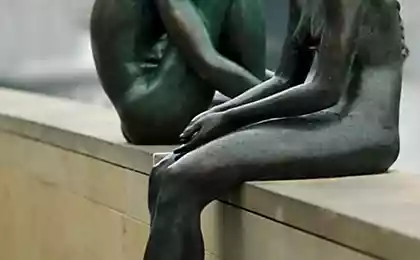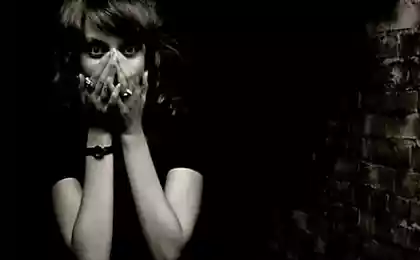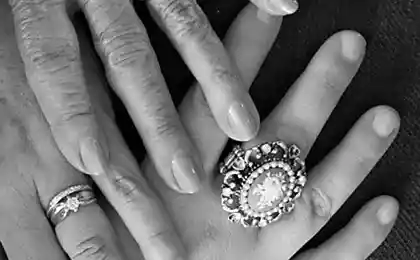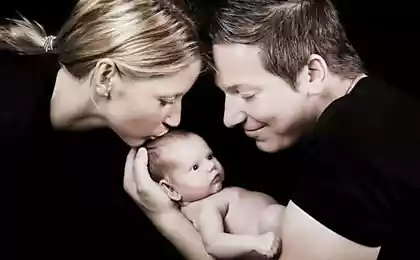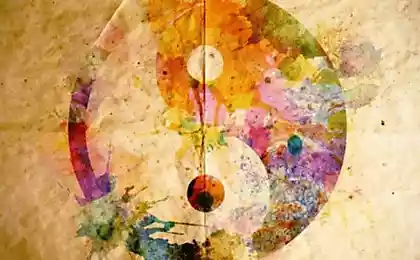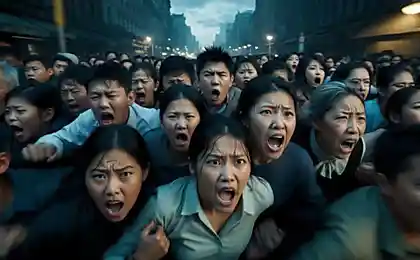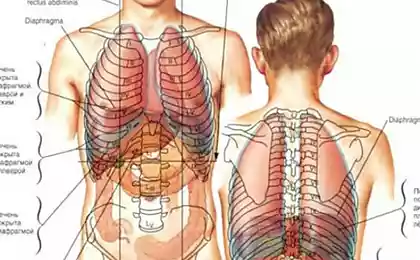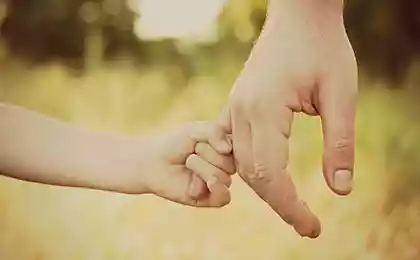791
Alexander Lowen: Anger and fear in the human body
Couple of emotions — anger and fear — is associated with the experience or anticipation of pain. Their appearance coincides with the development of the muscular system.
In the first year of life the child begins to react to pain and weakness voluntary movements. This is preceded by exclusively involuntary reaction in the form of crying, bending, and svivoni body and promiscuous kicks.
These actions Express a feeling of irritation, which later is replaced by anger. The emotion of anger is gradually replacing the lament as a means of discharging tension. However, the anger of a small child, as a rule, are not able to influence the situation and usually goes into mourning, which is the underlying mechanism for releasing stress.

* In General, anger is a more effective response than crying, as it is aimed at eliminating the causes of pain. To do this we need to be able to identify the cause and to understand what kind of object to channel the anger. While crying is accompanied by a feeling of helplessness in this situation, anger overcomes this feeling.
* In anger, the muscles along the back charged with excitement, mobilizing the body for attack. The anger felt like a wave moving up the back of the head and hands. A rush of emotions is accompanied by a powerful inflow of blood to these parts of the body. In the presence of inhibitions and stress, blocking the flow of feelings, you may experience a headache.
On the other hand, the cry is experienced as the outflow. During crying, the charge leaves the muscular system and the stress comes out through convulsive sobs. Anger in many ways similar to the storm: after the discharge of intense feelings through movement, the mind clears up and returns to good health, while crying can be compared with the quiet rain.
* Anger and fear are emotions that arise in emergency situations, they activate the sympathetic-adrenal system to provide extra energy for fight or flight. In both the emotional state of the muscular system is charged and mobilized to action. In the case of anger, the body prepares to attack the source of pain. If you experience fear, the body is configured to retreat and escape from danger.
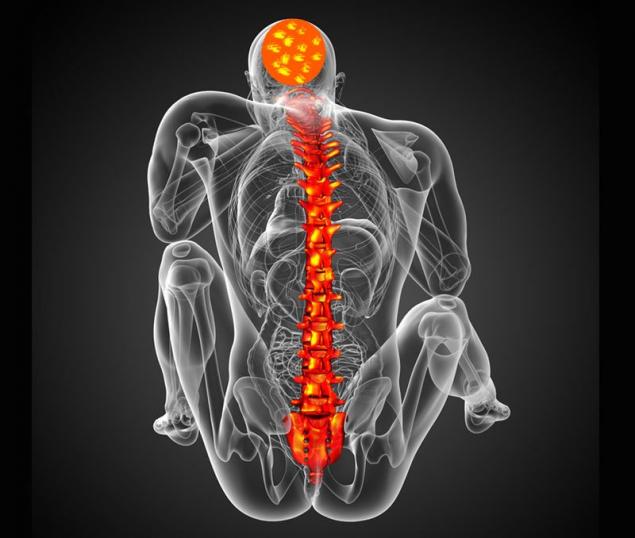
These two opposite directions of movement reflect what is happening in the body.
A movement up along the back, which the dog raises the hair on end together with the feed head forward and lowering the shoulders, is a preparation for attack. The result of a movement down along the back, becomes the retraction of the lower spine and the charging of the feet to escape.
In fear of the man turns and runs. If flight is impossible, the excitement gets in the back and neck, shoulders raised, eyes wide open, the head is moved back, the pelvis is drawn in. Being a typical expression of fear, this body posture indicates that the person is in a constant state of fear, regardless of whether he realizes it or not.
* The flow of excitation along the back to head in a moment of anger, probably due to the fact that in humans, like most mammals, the main means of expression of aggression serve the mouth and teeth. The impulse to bite is an archaic form of expression of anger.
Almost all children at a certain age bite, and sometimes it is done by adults, mostly women. This is a very effective form of attack, because it causes severe pain, but its disadvantage is the need for close contact.
So the impact, which is not as demanding on the course and allows for greater maneuverability, replaced with biting, becoming the main physical way of expressing anger. However, when a person gets really angry, his face often takes the expression of grin, which is associated with the bite.
* I am convinced that curbing the impulse to bite is largely responsible for many violations in the sphere of emotional expression. These violations take the form of inability to get angry, hysterical outbreaks, and the constant feeling of irritation.
Anger, like other basic emotions, is an expression of ego. He erupts like hysterical reactions, contrary to the conscious intentions, it is sent to ego and focused on a positive result, namely the elimination of the causes of frustration or pain.
Anger is not hostility, for angry does not mean to turn away or lose interest. Curbing the impulse to bite prevents the movement of excitation in the head and jaw and blocks the natural experience of the emotions.
* The failure of a person "catch the teeth for life" or "to bite into the ground" when necessary, is one of the results of the suppression of the impulse to bite.
I urge you to encourage the bites in the process of raising children, but they should not be punished for what they bite or some other way to Express your anger.
The person denied the right to Express anger, it turns out unprotected. Being brought to a state of fear and helplessness, he will try to overcome them by manipulating their environment. Bioenergy practice clearly shows that the chronic feelings of fear and helplessness hides a suppressed anger.
* The relationship between fear and anger is that one after the other. ESLIscared people will face danger and decide to attack, then he will get angry and stop being afraid. This is because the flow of excitement in his body changes direction. Its a new feeling — not that other, as the perception of this change. When the forward one begins to retreat, he for the same reason, getting scared. Anger finds an outlet in the movements of the attack. Fear is discharged through the escape.
* Fear develops when the source of pain presents a superior appearance and strength. The precaution advises man to retreat to avoid the pain, but the precaution is the voice of reason, and emotions are subject to conscious control. Whether people fight or flight will depend on his character and the situation.
Despite the superior forces of the aggressor, one can respond to violence with anger in those circumstances when retreat physically or psychologically inappropriate. Righteous anger gives a person a lot of effort and often enough to compensate for the lack of growth or weight. The person experiencing the anger, usually reinforces himself a conviction of the justice or the justification in their condition.
* On the other hand, in situations where anger could not be mobilized, due to the fact that the source of danger is uncertain, unknown or impersonal, the natural reaction is fear.
So, children are afraid when they are left in the dark alone. They feel helpless and either run away or start crying. For the same reason adults are afraid of the unknown. To tell the child that he should not be afraid of the dark, silly. It is possible to explain that there is no real danger in this situation does not exist, but it should be understood that his fear is a biological reaction that cannot be condemned.
We are doing irreparable harm to their children when we call them cowards and forced to be ashamed of their natural reactions. An irrational attitude of some adults is the result of ignorance of the essence of emotional reactions. In addition, it is to a certain extent is a acting out on their children that way, they faced themselves, being small and defenseless.
* While a frightened person arises spontaneously the impulse to escape, it can be blocked by willpower. InOlyais a mechanism operating in emergency situations under the control of the ego and can sometimes take precedence over emotional reaction. In some situations it can even save lives. Will, however, not reduce the feeling of fear. It allows a person to defend their position or to move forward despite the fear. Although it may be a manifestation of recklessness, as in cases where through fear the will is suppressed for the satisfaction of ego.
A chronic state of panicWhen the ego is identified with the body, it supports the emotional reactions of the body and sends them into effective action. If a man experiences fear, all actions of the ego are directed to avoid danger.

In the absence of control ego, which is supported by identifying with their own feelings, fear can easily escalate into panic. Similarly, when a person is angry, put ego limitations reduce his behavior to the necessary actions for halting or preventing pain or physical harm. Ego adds an element of rationality to the anger and not allow it to spiral out of control. Because anger usually subsides with the cessation of negative externalities, it cannot be considered a destructive action.
Another thing — rage. When identification of the ego with the body is reduced, leading to weakening control, the wave of anger often erupts in the form of rage, often have devastating effects on the person and his environment.
* Like most other manifestations of the personality, panic and rage diametrically interrelated to each other. In both cases the person feels trapped. Faced with insurmountable danger, which you can't respond with flight or fight, the person will feel panic, or anger.
Panic often occurs during war, when people blindly flee from the approaching enemy.
But it is difficult for us to imagine that panic may overwhelm the child, is threatened by an angry parent. He's literally trapped, and since neither fight nor flight is impossible for him. In such a situation, panic can take the form of hysterical screaming.
* Children living in conditions of constant threat, develop a chronic state of panic. With age they learn to suppress this feeling, but the effectiveness of such suppression is very relative. Depressed feeling bursts later, and in situations which, though stressful, do not justify, from a rational point of view, such an intense reaction.
Some people are so close to a state of panic, afraid to leave the house alone. I had to deal in practice with several cases like this. The other panic is hidden inside. It is usually evident in excessively raised, inflated chest, and difficulty breathing. People in a state of panic he feels that he is lacking air. Conversely, when a person feels that he is not getting enough air, he panics. Shortness of breath hides a blocked Creek.
If therapy Creek be released, the breathing becomes freer and the sense of panic is reduced.
* Human response to a threatening situation can also be a rage, especially in the presence of the object on which it can be directed. In this case muscular arousal becomes excessive, and the person loses control over their actions. Like panic, rage is blind. A man in a rage rushes to the attack headlong, without realizing the destructive consequences of their behavior. Unlike anger, rage is not so much particular external stimulus, as with the inner feeling of hopelessness.
* How can we explain the rage that some parents sometimes send their children? It is difficult to imagine that the child can become the parent of the reason for overwhelming fear. The explanation must be sought in the assumption that the child can call the parent a sense of hopelessness.
First of all, the mother attached to her child. She knows that she is obliged to provide him with constant care and attention he needs. If the energy levels are reduced, the child will become too much for her. In the situation of disadvantaged evolving relationship with her husband to be her chain, holding her in this relationship and, therefore, the cause of her pain.
If her own children's needs are not met, she will indignantly reject coming from your own child requirements love.
If motherhood becomes for her a source of pleasure and joy, she will feel trapped in obligations. And in moments of great stress, she will guide the child in their fury.
* Parental rage throws the baby in horror. For a detailed description of this condition I turn below, I would like to note that not only open expression of anger or violence has a similar effect.
The hidden cruelty of a parent that the child feels affects him the same way. The furious expression on the parents face is that the child does not understand and not able to cope. This is a direct threat to its existence.
I had to see the faces of the parents, with rage staring at their children. The parents, who were at this time in my office, didn't even realize what is written on their faces. My mother's face became dark as if a black cloud was hanging over her eyebrows. The position of the jaw was read ruthlessness. His eyes were cold and cruel. It was the look of a killer. When meeting with this child's view of paralyzing horror.
* In this state of paralysis muscular system, precluding any kind of fight or flight. Horror is a more intense form of fear, panic, and develops in situations where any effort to fight or flight, seems hopeless.
Horror is one of the forms of shock; feeling disconnected from the periphery of the body, reducing the body's sensitivity in anticipation of the onset of the last agony. This care themselves.
* The child experiencing the horror in the relationship with their parents, formed a schizoid personality. His body manifested all the signs: it becomes hard and rigid or soft, with weak muscle tone. The surface of the body is insufficiently charged. The eyes are usually empty, on the face stiff, like a mask, expression. Breathing heavily restricted by muscle spasms of the throat and bronchial tubes. Breath shallow, and his chest is held in a position of exhalation. The lack of movement leads to depersonalization, that is, the separation of perception from the ego body.
* This range of simple emotions and their descriptions are not complete and comprehensive. This is just a scheme that seem convenient in order to describe the existing biological system and show the mechanism of its functioning.published
©Alexander Lowen from the book "Pleasure: a Creative approach to life"
P. S. And remember, only by changing their consumption — together we change the world! ©
Source: //heatpsy.narod.ru/blog/gnev_i_strakh_v_tele_cheloveka/2015-12-15-206
In the first year of life the child begins to react to pain and weakness voluntary movements. This is preceded by exclusively involuntary reaction in the form of crying, bending, and svivoni body and promiscuous kicks.
These actions Express a feeling of irritation, which later is replaced by anger. The emotion of anger is gradually replacing the lament as a means of discharging tension. However, the anger of a small child, as a rule, are not able to influence the situation and usually goes into mourning, which is the underlying mechanism for releasing stress.

* In General, anger is a more effective response than crying, as it is aimed at eliminating the causes of pain. To do this we need to be able to identify the cause and to understand what kind of object to channel the anger. While crying is accompanied by a feeling of helplessness in this situation, anger overcomes this feeling.
* In anger, the muscles along the back charged with excitement, mobilizing the body for attack. The anger felt like a wave moving up the back of the head and hands. A rush of emotions is accompanied by a powerful inflow of blood to these parts of the body. In the presence of inhibitions and stress, blocking the flow of feelings, you may experience a headache.
On the other hand, the cry is experienced as the outflow. During crying, the charge leaves the muscular system and the stress comes out through convulsive sobs. Anger in many ways similar to the storm: after the discharge of intense feelings through movement, the mind clears up and returns to good health, while crying can be compared with the quiet rain.
* Anger and fear are emotions that arise in emergency situations, they activate the sympathetic-adrenal system to provide extra energy for fight or flight. In both the emotional state of the muscular system is charged and mobilized to action. In the case of anger, the body prepares to attack the source of pain. If you experience fear, the body is configured to retreat and escape from danger.

These two opposite directions of movement reflect what is happening in the body.
A movement up along the back, which the dog raises the hair on end together with the feed head forward and lowering the shoulders, is a preparation for attack. The result of a movement down along the back, becomes the retraction of the lower spine and the charging of the feet to escape.
In fear of the man turns and runs. If flight is impossible, the excitement gets in the back and neck, shoulders raised, eyes wide open, the head is moved back, the pelvis is drawn in. Being a typical expression of fear, this body posture indicates that the person is in a constant state of fear, regardless of whether he realizes it or not.
* The flow of excitation along the back to head in a moment of anger, probably due to the fact that in humans, like most mammals, the main means of expression of aggression serve the mouth and teeth. The impulse to bite is an archaic form of expression of anger.
Almost all children at a certain age bite, and sometimes it is done by adults, mostly women. This is a very effective form of attack, because it causes severe pain, but its disadvantage is the need for close contact.
So the impact, which is not as demanding on the course and allows for greater maneuverability, replaced with biting, becoming the main physical way of expressing anger. However, when a person gets really angry, his face often takes the expression of grin, which is associated with the bite.
* I am convinced that curbing the impulse to bite is largely responsible for many violations in the sphere of emotional expression. These violations take the form of inability to get angry, hysterical outbreaks, and the constant feeling of irritation.
Anger, like other basic emotions, is an expression of ego. He erupts like hysterical reactions, contrary to the conscious intentions, it is sent to ego and focused on a positive result, namely the elimination of the causes of frustration or pain.
Anger is not hostility, for angry does not mean to turn away or lose interest. Curbing the impulse to bite prevents the movement of excitation in the head and jaw and blocks the natural experience of the emotions.
* The failure of a person "catch the teeth for life" or "to bite into the ground" when necessary, is one of the results of the suppression of the impulse to bite.
I urge you to encourage the bites in the process of raising children, but they should not be punished for what they bite or some other way to Express your anger.
The person denied the right to Express anger, it turns out unprotected. Being brought to a state of fear and helplessness, he will try to overcome them by manipulating their environment. Bioenergy practice clearly shows that the chronic feelings of fear and helplessness hides a suppressed anger.
* The relationship between fear and anger is that one after the other. ESLIscared people will face danger and decide to attack, then he will get angry and stop being afraid. This is because the flow of excitement in his body changes direction. Its a new feeling — not that other, as the perception of this change. When the forward one begins to retreat, he for the same reason, getting scared. Anger finds an outlet in the movements of the attack. Fear is discharged through the escape.
* Fear develops when the source of pain presents a superior appearance and strength. The precaution advises man to retreat to avoid the pain, but the precaution is the voice of reason, and emotions are subject to conscious control. Whether people fight or flight will depend on his character and the situation.
Despite the superior forces of the aggressor, one can respond to violence with anger in those circumstances when retreat physically or psychologically inappropriate. Righteous anger gives a person a lot of effort and often enough to compensate for the lack of growth or weight. The person experiencing the anger, usually reinforces himself a conviction of the justice or the justification in their condition.
* On the other hand, in situations where anger could not be mobilized, due to the fact that the source of danger is uncertain, unknown or impersonal, the natural reaction is fear.
So, children are afraid when they are left in the dark alone. They feel helpless and either run away or start crying. For the same reason adults are afraid of the unknown. To tell the child that he should not be afraid of the dark, silly. It is possible to explain that there is no real danger in this situation does not exist, but it should be understood that his fear is a biological reaction that cannot be condemned.
We are doing irreparable harm to their children when we call them cowards and forced to be ashamed of their natural reactions. An irrational attitude of some adults is the result of ignorance of the essence of emotional reactions. In addition, it is to a certain extent is a acting out on their children that way, they faced themselves, being small and defenseless.
* While a frightened person arises spontaneously the impulse to escape, it can be blocked by willpower. InOlyais a mechanism operating in emergency situations under the control of the ego and can sometimes take precedence over emotional reaction. In some situations it can even save lives. Will, however, not reduce the feeling of fear. It allows a person to defend their position or to move forward despite the fear. Although it may be a manifestation of recklessness, as in cases where through fear the will is suppressed for the satisfaction of ego.
A chronic state of panicWhen the ego is identified with the body, it supports the emotional reactions of the body and sends them into effective action. If a man experiences fear, all actions of the ego are directed to avoid danger.

In the absence of control ego, which is supported by identifying with their own feelings, fear can easily escalate into panic. Similarly, when a person is angry, put ego limitations reduce his behavior to the necessary actions for halting or preventing pain or physical harm. Ego adds an element of rationality to the anger and not allow it to spiral out of control. Because anger usually subsides with the cessation of negative externalities, it cannot be considered a destructive action.
Another thing — rage. When identification of the ego with the body is reduced, leading to weakening control, the wave of anger often erupts in the form of rage, often have devastating effects on the person and his environment.
* Like most other manifestations of the personality, panic and rage diametrically interrelated to each other. In both cases the person feels trapped. Faced with insurmountable danger, which you can't respond with flight or fight, the person will feel panic, or anger.
- If it's panic, his impulse would be desperate, uncontrolled desire to get away from danger at any cost. If the opportunity arises, he will run without looking back, not even trying to assess the situation; there is a complete lack of control by the ego.
- If escape is impossible, his reaction is rage.
Panic often occurs during war, when people blindly flee from the approaching enemy.
But it is difficult for us to imagine that panic may overwhelm the child, is threatened by an angry parent. He's literally trapped, and since neither fight nor flight is impossible for him. In such a situation, panic can take the form of hysterical screaming.
* Children living in conditions of constant threat, develop a chronic state of panic. With age they learn to suppress this feeling, but the effectiveness of such suppression is very relative. Depressed feeling bursts later, and in situations which, though stressful, do not justify, from a rational point of view, such an intense reaction.
Some people are so close to a state of panic, afraid to leave the house alone. I had to deal in practice with several cases like this. The other panic is hidden inside. It is usually evident in excessively raised, inflated chest, and difficulty breathing. People in a state of panic he feels that he is lacking air. Conversely, when a person feels that he is not getting enough air, he panics. Shortness of breath hides a blocked Creek.
If therapy Creek be released, the breathing becomes freer and the sense of panic is reduced.
* Human response to a threatening situation can also be a rage, especially in the presence of the object on which it can be directed. In this case muscular arousal becomes excessive, and the person loses control over their actions. Like panic, rage is blind. A man in a rage rushes to the attack headlong, without realizing the destructive consequences of their behavior. Unlike anger, rage is not so much particular external stimulus, as with the inner feeling of hopelessness.
* How can we explain the rage that some parents sometimes send their children? It is difficult to imagine that the child can become the parent of the reason for overwhelming fear. The explanation must be sought in the assumption that the child can call the parent a sense of hopelessness.
First of all, the mother attached to her child. She knows that she is obliged to provide him with constant care and attention he needs. If the energy levels are reduced, the child will become too much for her. In the situation of disadvantaged evolving relationship with her husband to be her chain, holding her in this relationship and, therefore, the cause of her pain.
If her own children's needs are not met, she will indignantly reject coming from your own child requirements love.
If motherhood becomes for her a source of pleasure and joy, she will feel trapped in obligations. And in moments of great stress, she will guide the child in their fury.
* Parental rage throws the baby in horror. For a detailed description of this condition I turn below, I would like to note that not only open expression of anger or violence has a similar effect.
The hidden cruelty of a parent that the child feels affects him the same way. The furious expression on the parents face is that the child does not understand and not able to cope. This is a direct threat to its existence.
I had to see the faces of the parents, with rage staring at their children. The parents, who were at this time in my office, didn't even realize what is written on their faces. My mother's face became dark as if a black cloud was hanging over her eyebrows. The position of the jaw was read ruthlessness. His eyes were cold and cruel. It was the look of a killer. When meeting with this child's view of paralyzing horror.
* In this state of paralysis muscular system, precluding any kind of fight or flight. Horror is a more intense form of fear, panic, and develops in situations where any effort to fight or flight, seems hopeless.
Horror is one of the forms of shock; feeling disconnected from the periphery of the body, reducing the body's sensitivity in anticipation of the onset of the last agony. This care themselves.
* The child experiencing the horror in the relationship with their parents, formed a schizoid personality. His body manifested all the signs: it becomes hard and rigid or soft, with weak muscle tone. The surface of the body is insufficiently charged. The eyes are usually empty, on the face stiff, like a mask, expression. Breathing heavily restricted by muscle spasms of the throat and bronchial tubes. Breath shallow, and his chest is held in a position of exhalation. The lack of movement leads to depersonalization, that is, the separation of perception from the ego body.
* This range of simple emotions and their descriptions are not complete and comprehensive. This is just a scheme that seem convenient in order to describe the existing biological system and show the mechanism of its functioning.published
©Alexander Lowen from the book "Pleasure: a Creative approach to life"
P. S. And remember, only by changing their consumption — together we change the world! ©
Source: //heatpsy.narod.ru/blog/gnev_i_strakh_v_tele_cheloveka/2015-12-15-206
Home Life Hack: Nettle instead of poisons and pesticides!
Audi will bring to Shanghai electric with the glowing logo
